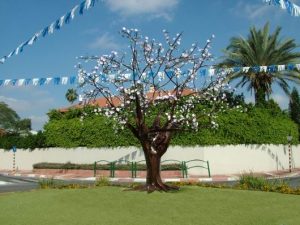
A statue of an almond tree, commemorating the legacy of the 10 founding families of the ‘First Minyan’ in ‘Wadi El Hanin’ is placed in the square next to the Biological Institute in Nes Ziona
The statue, which was designed and designed by the artist Israel Primo from the Netish Gallery, was donated to the residents of the city by the families, descendants of the Biloyim Shlomo Yaffe and Golda Miloslavsky, who were among the first settlers in Wadi El Hanin
On April 14, 2010, a statue of an almond tree was placed in the square of the Biological Institute in Nes Ziona, to commemorate the legacy of the ten founding families of the city, the first quorum for the settlers of Wadi Al Hanin (Valley of the Roses – the first name of Nes Ziona).

The sculpture, designed and designed by Israel Primo, the artist, designer and creator from Natish Gallery, is an exact and spectacular replica of an almond tree in full bloom. The almond tree reached a height of about 3 meters and over 1,500 almond blossoms were attached to its branches. The entire tree is handmade by blacksmiths and ironsmiths, painted with a unique technique that preserves the authenticity of the iron and its natural texture.
In the square surrounding the statue, various flowers were planted, the most prominent among them being the Damask rose, which was common in Ness Ziona at the time of its construction. On one of the sidewalks around the square, a rock made of Jerusalem stone was placed on which were engraved the names of the first ten families in the city, with the year of their settlement in Wadi El Hanin indicated next to each name.
The statue was donated to the residents of Ness Ziona by two members of the family of the descendants of the Biloyim Shlomo Yaffe and Golda Miloslavsky, who were the second in number to settle in Wadi El Hanin.
The representative of the donor family, Jacob Feldman (87), born in Ness Ziona in 1922, tells about the origin of the idea for the sculptural installation: “The first settlers in Wadi El Hanin tried their hand at different crops on an area spread over about 500 dunams of arid land, including vineyards and tobacco Since these crops did not succeed, almond trees were planted which lasted until the end of World War II. We found it appropriate to place an almond tree in the place, which is a symbol of the primary agriculture in the place.”
Feldman says that the idea to plant a damask rose arose from a story that had been unfolding in his family for many years and according to which, in 1898, during Benjamin Ze’ev Herzl’s first visit to Israel, he visited the home of Golda Milosvalsky, who honored him with a bouquet of damask roses.
The collaboration with the artist Israel Primo is defined by Feldman as particularly fruitful:
“The family is full of admiration for the artistic work of the creator Israel Primo. For many years we have been looking for a way to perpetuate the legacy of the founders of the city of Nes Ziona and today we are moved by the result.”
About Natish Gallery, creating functional design and art
Netish Gallery, located in Nes Ziona, has been engaged in design and works of art and sculpture since 1986, unique furniture, lighting fixtures, railings, decorative objects, Judaica and more. The uniqueness and power of Netish is the combination of functional design and art, where the touch of goldsmithing is evident in all the works of the gallery. The gallery has a huge exhibition hall with works that show the purpose of the gallery’s capabilities.
Israel Primo – the artist, designer and creator behind Natish Gallery,
Ysrael Primo, the artist, designer and creator behind Natish Gallery deals with a wide range of artistic design. The strength and uniqueness of Primo is the use of artistic techniques drawn from the world of goldsmiths and traditional ironsmiths, which is reflected in original and unique creations of environmental jewelry. Primo’s artistic concept is not drawn from the academy, but clean, detached from patterns and not subject to accepted frameworks and norms. His works have original thinking with a unique and different presence, have a bold and dramatic design character alongside other transparent, soft and airy works.
In addition to private projects, Primo is engaged in the design and construction of special projects, such as: sculpture in the public space, design of public buildings, design of restaurants, cafes and bars, halls, offices and more.
Many sculptural works by Primo are placed in various cities throughout the country including: Nes Ziona, Rehovot, Rosh Ha’Ein, Holon, Hadera, Bat Yam, Beer Sheva, Petah Tikva, Ashdod, Tiberias, Yavneh, the Dead Sea and more.

 Call now
Call now

